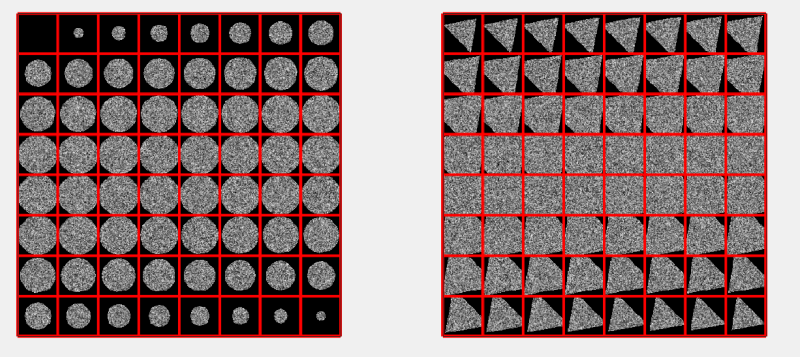Difference between revisions of "Border alignment artifact"
Jump to navigation
Jump to search
(Created page with " When rotating a cube, the cube representing the rotated particle will have some areas where there is no information. See the effect here. {/code} u1=dynamo_rot(rand(64,...") |
|||
| (11 intermediate revisions by the same user not shown) | |||
| Line 2: | Line 2: | ||
When rotating a cube, the cube representing the rotated particle will have some areas where there is no information. | When rotating a cube, the cube representing the rotated particle will have some areas where there is no information. | ||
| − | See the effect here | + | As a consequence, a rotated particle appears as showing an "edge". Most ''Dynamo'' programs rotate the volume into an sphere. However, sometimes it is necessary to keep the edges, for instance during [[Fourier compensation during averaging|fourier compensation during average]] |
| − | + | ||
| − | + | ||
| − | + | See the effect here: | |
| − | + | ||
| − | + | <pre> | |
| − | + | u1=dynamo_rot(rand(64,64,64),[45,45,45]); % rotates creating a spherical halo | |
| − | + | u2=dpkgeom.rotation.sharpRot(rand(64,64,64),[45,45,45]); % rotates creating an edge | |
| + | figure; | ||
| + | subplot(1,2,1);dslices(u1);subplot(1,2,2);dslices(u2); | ||
| + | </pre> | ||
| + | |||
| + | |||
| + | [[File:RotationArtifact.png|thumb|center|800px| Different treatment of corners during rotation ]] | ||
Latest revision as of 08:33, 13 October 2017
When rotating a cube, the cube representing the rotated particle will have some areas where there is no information.
As a consequence, a rotated particle appears as showing an "edge". Most Dynamo programs rotate the volume into an sphere. However, sometimes it is necessary to keep the edges, for instance during fourier compensation during average
See the effect here:
u1=dynamo_rot(rand(64,64,64),[45,45,45]); % rotates creating a spherical halo u2=dpkgeom.rotation.sharpRot(rand(64,64,64),[45,45,45]); % rotates creating an edge figure; subplot(1,2,1);dslices(u1);subplot(1,2,2);dslices(u2);
